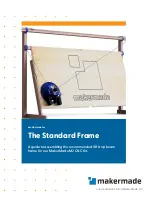
W2630
Safety Information
© Atlas Copco Industrial Technique AB - 9836 5252 00
5
Our goal is to produce tools that help you work safely and ef-
ficiently. The most important safety device for this or any
tool is YOU. Your care and good judgment are the best pro-
tection against injury. All possible hazards cannot be covered
here, but we have tried to highlight some of the important
ones.
• Only qualified and trained operators should install, ad-
just or use this power tool.
• This tool and its accessories must not be modified in any
way.
• Do not use this tool if it has been damaged.
• If the rated speed, operating pressure or hazard warning
signs on the tool cease to be legible or become detached,
replace without delay.
For additional safety information consult:
• Other documents and information packed with this
tool.
• Your employer, union and / or trade association.
• “Safety Code for Portable Air Tools” (ANSI
B186.1), available at the time of printing from
Global Engineering Documents at http://
global.ihs.com/ , or call 1 800 854 7179. In case of
difficulty in obtaining ANSI standards, contact
ANSI via http://www.ansi.org/
• Further occupational health and safety information
can be obtained from the following web sites:
• http://www.osha.gov (USA)
• https://osha.europa.eu/ (Europe)
Air supply and connection hazards
• Air under pressure can cause severe injury.
• Always shut off air supply, drain hose of air pressure and
disconnect tool from air supply when not in use, before
changing accessories or when making repairs.
• Never direct air at yourself or anyone else.
• Whipping hoses can cause severe injury. Always check
for damaged or loose hoses and fittings.
• Do not use quick disconnect couplings at tool. See in-
structions for correct set up.
• Whenever universal twist couplings are used, lock pins
must be installed.
• Do not exceed maximum air pressure of 6.3 bar / 90
psig, or as stated on tool nameplate.
Entanglement hazards
• Keep away from rotating drive. Choking, scalping and /
or lacerations can occur if loose clothing, gloves, jew-
ellery, neck ware and hair are not kept away from tool
and accessories.
• Gloves can become entangled with the rotating drive,
causing severed or broken fingers.
• Rotating drive sockets and drive extensions can easily
entangle rubber-coated or metal-reinforced gloves.
• Do not wear loose-fitting gloves or gloves with cut or
frayed fingers.
• Never hold the drive, socket or drive extension.
Projectile hazards
• Always wear impact-resistant eye and face protection
when involved with or near the operation, repair or
maintenance of the tool or changing accessories on the
tool.
• Be sure all others in the area are wearing impact-resis-
tant eye and face protection. Even small projectiles can
injure eyes and cause blindness.
• Serious injury can result from over-torqued or under-
torqued fasteners, which can break, or loosen and sepa-
rate. Released assemblies can become projectiles. As-
semblies requiring a specific torque must be checked us-
ing a torque meter.
NOTE So-called “click” torque wrenches do not check
for potentially dangerous over-torqued conditions.
• Use only impact wrench rated sockets and accessories in
good condition. Sockets in poor condition or hand sock-
ets and accessories used with impact wrenches can shat-
ter.
• Never operate the tool off the work. It may run too fast
and cause the accessory to be thrown off the tool.
• Ensure that the workpiece is securely fixed.
Accessory hazards
• Use only proper accessory retainers (see parts list). Use
deep sockets wherever possible.
• For tools using the pin and O-ring socket retention sys-
tem, use the O-ring to retain the socket pin securely.
• Always use the simplest hook-up possible. Long, springy
extension bars and adapters absorb impact power and
could break. Use deep sockets wherever possible.
Operating hazards
• Operators and maintenance personnel must be physically
able to handle the bulk, weight and power of the tool.
• Hold the tool correctly: be ready to counteract normal or
sudden movements – have both hands available.
• Do not use with reduced air pressure or in a worn condi-
tion: the clutch may not operate, resulting in sudden rota-
tion of the tool handle.
• Be in control of the throttle at all times. Do not get
caught between the tool and the work.
Repetitive motion hazards
• When using a power tool to perform work-related activi-
ties, the operator might experience discomfort in the
hands, arms, shoulders, neck, or other parts of the body.
• Adopt a comfortable posture whilst maintaining secure
footing and avoiding awkward or off-balance postures.
Changing posture during extended tasks can help avoid
discomfort and fatigue.
• Do not ignore symptoms such as persistent or recurring
discomfort, pain, throbbing, aching, tingling, numbness,
burning sensation, or stiffness. Stop using the tool, tell
your employer and consult a physician.






































